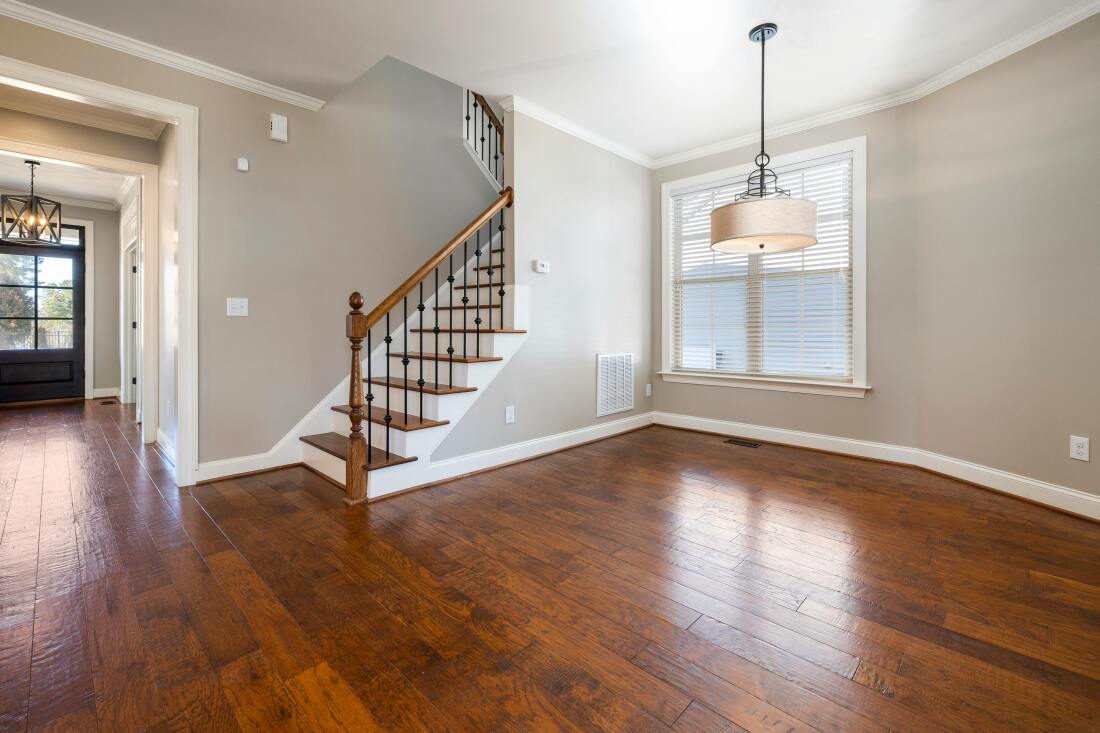
Tongue & Groove Flooring VS Click Lok Flooring
February 23, 2024Stepping into a new flooring project can be daunting, especially when faced with two popular options: Tongue & Groove and Click Lock. Both offer distinct advantages, appealing to different needs and preferences. Whether you value time-tested methods or prioritize rapid installation, understanding the nuances of each is key.
Introduction
Click-lock flooring, also known as click flooring, has gained popularity among homeowners and DIY enthusiasts for its easy installation process and durability. This type of flooring is a traditional design with a specially engineered "click" system that allows planks to easily and securely lock into place, eliminating the need for adhesives or nails.
The click system works by simply lining up the planks at an angle and then clicking them together, creating a tight and seamless connection. This feature makes click-lock flooring a popular choice for DIY projects, as it significantly reduces the time and effort required for installation.
Additionally, click-lock flooring is commonly used for floating installations, meaning it can be laid directly over existing subfloors without the need for extensive preparation. This versatility makes it an attractive option for those looking to update their laminate flooring locks without the hassle of removing the old ones.
Overall, the benefits and features of click-lock flooring, including its easy installation process and suitability for DIY projects, make it a popular choice for homeowners looking to enhance the aesthetics and functionality of their spaces.
Brief overview of tongue & groove flooring and click-lok flooring
Tongue & groove flooring features interlocking edges that fit together to create a strong and stable floor. Installation involves sliding the tongue of one plank into the groove of another and securing it in place. This type of flooring is known for its durability and ability to withstand heavy foot traffic.
Click-lock flooring, on the other hand, is designed with a locking system that allows planks to snap together without the need for glue or nails. This makes installation quick and easy, as the planks simply click into place, making it a popular choice for DIY projects. Click lock flooring is versatile and can be installed over most existing floors, saving time and money.
Tongue & groove flooring offers a traditional and secure installation method, but may require more time and effort. On the other hand, a click-lock floor provides a convenient and efficient installation process, with the drawback of potentially being less stable over time. In terms of durability, tongue-and-groove hardwood floors are typically more resilient, while click-lock flooring may be more susceptible to damage from heavy use. Both types of flooring have their advantages and disadvantages, so it's important to consider the specific needs and preferences of the space being renovated.
Importance of choosing the right flooring system for your space
Choosing the right flooring system for your space is crucial for both the aesthetic and functional aspects of your environment. The type of solid wood flooring you select can impact the overall feel of a room, as well as its durability and maintenance. Factors such as the amount of foot traffic, moisture levels, and range of design preferences all play a role in determining the most suitable wooden flooring option. From hardwood and laminate to tile and carpet, each laminate floor system offers unique benefits and considerations that must be carefully evaluated to ensure the best choice for your space. Making an informed decision about your flooring can not only enhance the visual appeal of your space but also contribute to its long-term resilience and value. Therefore, it is essential to prioritize the importance of selecting the right flooring system for any given area.
Installation Methods
Tongue and groove (T&G) wood flooring is installed by connecting the tongue of one plank to the groove of another, creating a strong and tight fit. This can be achieved by either gluing the joints together, secretly nailing the planks to the subfloor, or using the floating method by placing the planks over an underlayment without any attachment to the subfloor.
On the other hand, click lock wood flooring utilizes a locking system that easily snaps the planks together, eliminating the need for glue or nails. The click lock system is ideal for floating installations, where the planks are laid over an underlayment without any attachment to the subfloor. This method allows for easy installation and allows the floor to expand and contract with changes in temperature and humidity.
Both T&G and Click Lock wood flooring are popular choices due to their easy installation methods, providing a versatile and durable flooring option for any space.
Explanation of traditional tongue & groove installation method
The traditional tongue-and-groove installation method involves fitting the planks together to create a seamless and durable paper finish. The process begins by placing the first plank along one wall, with the groove side facing the wall. The next plank is then inserted into the grooved side of the first plank at a slight angle and then lowered to fit snugly into place. This process is repeated across the entire wooden floor, interlocking each plank with the previous one.
Once all the planks are fitted together, they are secured to the subfloor using various traditional methods such as gluing down, secret nailing, or floating installation. Gluing down involves applying adhesive to the subfloor and then pressing the planks into place. Secret nailing requires driving nails into the tongues of the planks at a 45-degree angle to secure them in place. Floating installation involves no attachment to the subfloor but relies on the interlocking mechanism of the tongue and groove to hold the planks together.
Overall, the tongue-and-groove installation method provides a smooth and durable finish, making it a popular choice for hardwood and engineered wood flooring.

Discussion on the ease and convenience of click-lok installation
When it comes to installing flooring, the ease and convenience of click-lok installation can make a significant difference. This method allows for the quick and straightforward installation of flooring, making it accessible for both professional contractors and confident DIYers. Whether it's hardwood, laminate, or luxury vinyl planks, Click-Lok systems provide a hassle-free way to upgrade your floors without the need for special adhesives or tools. In this discussion, we will explore the various benefits and advantages of click-lok installation, as well as tips for ensuring a smooth and successful installation process. Whether you're looking to refresh a single room or your entire home, understanding the ease and convenience of click-lok installation can help you make an informed decision about your flooring project.
Solid Subfloor
A solid subfloor is crucial for any successful flooring installation. It provides the stability and support needed to ensure the longevity and durability of the new flooring. Inspecting the subfloor for any damage or weak spots is essential to avoid potential issues and ensure a smooth and even surface for the new flooring.
Before proceeding with any flooring installation, it is important to thoroughly inspect the subfloor for stability. This can be done by walking over the entire surface, checking for any squeaking, dipping, or movement. It is also important to visually inspect the subfloor for any signs of damage, such as cracks, rot, or water damage.
If any issues are found, they should be addressed before proceeding with the installation. This may involve repairing or replacing damaged sections of the subfloor to ensure a stable and solid base for the new flooring.
In conclusion, ensuring a solid and stable subfloor is essential for a successful flooring installation. Thoroughly inspecting the subfloor for any damage and addressing any issues before proceeding will help to ensure a smooth and long-lasting result.
Considerations for solid subfloors when choosing between tongue-and-groove and click-lok flooring
When choosing between tongue-and-groove and click-lok flooring, it's important to consider the characteristics of the solid subfloor. Understanding the specific conditions of the subfloor will help determine which type of flooring will be the best fit for the space. Factors such as moisture levels, stability, and the smoothness of the subfloor will all play a crucial role in making the right decision for your flooring installation. By carefully considering these considerations for solid subfloors, you can ensure that your chosen flooring type will be able to perform optimally and withstand the demands of the environment it will be placed in.
Protruding Edge
When identifying a protruding edge in a work or living space, carefully inspect the area for any sharp or jutting corners or edges that could pose a risk of injury. If you encounter a protruding edge, mark it with brightly colored tape or paint to increase visibility and remind people to use caution around the area. Consider using corner guards or edge protectors to minimize the risk of injury from accidentally bumping into the edge. If the protruding edge cannot be eliminated, create a visual barrier with a piece of furniture or other obstructions to prevent accidental collisions and minimize the risk of injury. It is crucial to take safety measures to address protruding edges and prevent accidents. By being proactive in identifying and addressing protruding edges, we can ensure a safer work and living environment for everyone.
High-Quality Underlay
High-quality underlay plays a crucial role in enhancing the durability and longevity of flooring. It provides insulation to keep floors warm and can significantly reduce sound transmission between floors, creating a quieter and more peaceful environment.
Rubber underlay is ideal for heavy-traffic areas, such as hallways and commercial spaces, as it offers excellent support and impact resistance. Foam underlay, on the other hand, is suitable for laminate and engineered wood flooring, as it provides cushioning and helps to smooth out minor subfloor imperfections. A felt underlay is commonly used with carpets and provides a luxurious feel underfoot as well as excellent sound reduction.
Each type of underlay offers unique benefits, but all contribute to improved flooring performance. By choosing the right underlay for the specific flooring material and application, one can enjoy extended flooring durability, improved insulation, and reduced noise levels throughout the space.
Importance of using high-quality underlay for both types of flooring systems
Underlay is an often overlooked but crucial component of any flooring system, whether it's for carpet or hard flooring. The importance of using a high-quality underlay cannot be overemphasized enough, as it provides numerous benefits that contribute to the overall comfort, durability, and performance of the flooring. Whether it's reducing noise transmission, providing insulation, or prolonging the life of the flooring, investing in quality underlay is essential for both carpet and hard flooring systems. This article will explore the specific advantages of using high-quality underlay for both types of flooring systems and why it is a worthwhile investment.
Secret Nailing vs Click Locking System
Secret nailing and click locking are two common methods used to install engineered hardwood flooring.
Secret nailing involves using a nail gun to drive nails through the tongue of each hardwood plank at a 45-degree angle, hiding the nails beneath the next row of planks. This method requires a pneumatic nail gun, nails, and a compressor. It provides a secure and stable installation but can be time-consuming and may require professional skills.
On the other hand, click locking systems involve interlocking the tongue and groove of each plank, eliminating the need for nails or adhesive. This method is relatively easier to install, making it suitable for DIY enthusiasts. However, it may be less durable and stable compared to secret nailing.
The advantages of secret nailing include a strong and secure installation, while click locking offers an easier and quicker installation. Disadvantages of secret nailing include the need for professional skills and time-consuming installation, while click locking may be less durable and stable.
In summary, the choice between secret nailing and click locking systems depends on the level of expertise, time, and desired durability. Regardless of the method chosen, it is essential to follow manufacturer guidelines and ensure proper subfloor preparation for a successful installation.
Professional Fitter
To become a professional fitter, one typically needs to have a high school diploma or equivalent, as well as complete an apprenticeship or vocational training program. Some employers may also require certification in specific areas of fitting, such as plumbing or HVAC systems. Experience in a related field, such as construction or manufacturing, is also valuable.
The responsibilities of a professional fitter often include reading and interpreting blueprints or technical drawings, measuring and cutting materials to precise specifications, assembling and fitting components together, and testing for proper function. Attention to detail is crucial in this role, as even a small error in measurement or assembly can lead to significant problems. Problem-solving skills are also essential for troubleshooting and adjusting fittings to ensure they meet requirements.
Physical stamina is important as well, as professional fitters often work in challenging environments and may need to lift heavy materials or work in awkward positions. Overall, the combination of qualifications, training, and experience, along with a strong focus on attention to detail, problem-solving skills, and physical stamina, is critical for success in the field of professional fitting.

Benefits of hiring a professional fitter for both types of flooring installations
When it comes to installing new flooring, whether it's hardwood or carpet, hiring a professional fitter can offer a myriad of benefits. From ensuring proper installation to saving time and minimizing potential damage, professionals have the expertise and tools to get the job done right the first time. This article will explore the key advantages of hiring a professional fitter for both types of flooring installations, highlighting the value that skilled professionals bring to the table.
Flooring Systems
Tongue and groove and click systems are two popular types of flooring systems, each with its own set of considerations.
Tongue-and-groove flooring typically involves interlocking wider planks that are secured in place using nails or adhesive. This installation process can be more time-consuming and may require professional help, which can increase the overall labour cost. However, tongue and groove flooring is known for its durability and stability, making it a suitable choice for projects that require long-lasting and sturdy flooring.
On the other hand, click system flooring is designed for easy installation, as the wooden planks simply click together without the need for nails or adhesive. This can significantly reduce installation and manufacturing costs and is a great choice for DIY projects or budget-friendly renovations. Click system flooring may not offer the same level of stability as tongue and groove, but it is a convenient option for projects with specific budget constraints or time limitations.
When choosing between the two systems, it's important to consider the specific project requirements, such as budget, installation timeline, and the desired level of stability. Tongue and groove flooring may be more suitable for long-term projects that require durability, while click system flooring is an installation-cost option for quick, budget-friendly renovations.
Unlock the Secrets: Compare Tongue & Groove vs. Click Lock in Our Detailed Guide!
Schedule a free consultation. Let us help you choose the ideal flooring for your home!
- Visit our website today!
- Click here and discover your perfect floor today!





